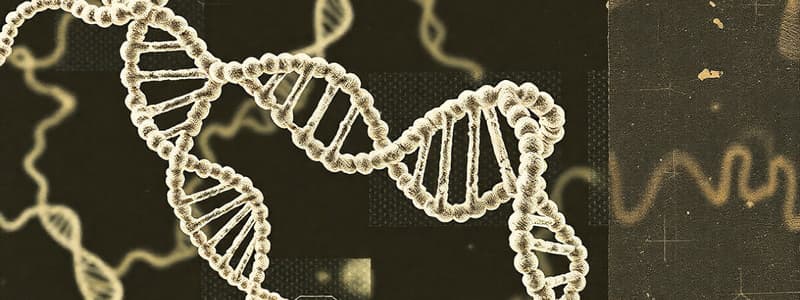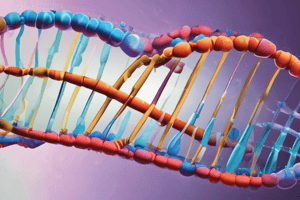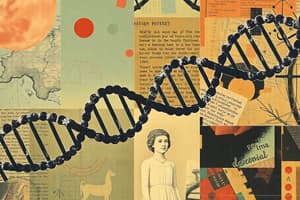Podcast
Questions and Answers
Match the following scientists with their primary discoveries related to DNA.
Match the following scientists with their primary discoveries related to DNA.
Griffith = Demonstrated that genetic material could be transferred between bacteria through transformation. Avery, McCarty, and MacLeod = Identified DNA as the transforming principle, disproving the protein hypothesis. Hershey and Chase = Confirmed DNA as the genetic material using bacteriophages and radioactive labeling. Wilkins and Franklin = Used X-ray diffraction to deduce DNA's helical structure. Watson and Crick = Proposed the double helix model of DNA, incorporating Chargaff's rules and base pairing.
Which of the following describes the process by which DNA replicates?
Which of the following describes the process by which DNA replicates?
- Conservative replication: The original DNA molecule remains intact, and a completely new copy is created.
- Dispersive replication: The original DNA molecule is broken into fragments, and each fragment is replicated, resulting in a mixture of old and new DNA in the daughter molecules.
- Semiconservative replication: Each daughter DNA molecule contains one original strand and one newly synthesized strand. (correct)
What are the four nitrogenous bases found in DNA?
What are the four nitrogenous bases found in DNA?
Adenine, guanine, cytosine, and thymine.
Which of these is NOT a component of a nucleotide?
Which of these is NOT a component of a nucleotide?
DNA polymerase can synthesize a new DNA strand in both the 5' to 3' and the 3' to 5' directions.
DNA polymerase can synthesize a new DNA strand in both the 5' to 3' and the 3' to 5' directions.
What is the main function of DNA polymerase III in DNA replication?
What is the main function of DNA polymerase III in DNA replication?
Which enzyme is responsible for creating RNA primers during DNA replication?
Which enzyme is responsible for creating RNA primers during DNA replication?
What are the short, newly synthesized DNA fragments on the lagging strand called?
What are the short, newly synthesized DNA fragments on the lagging strand called?
The enzyme ______ removes torsional strain that builds up ahead of the replication fork during DNA unwinding.
The enzyme ______ removes torsional strain that builds up ahead of the replication fork during DNA unwinding.
What is the purpose of telomeres?
What is the purpose of telomeres?
Which of the following is TRUE regarding Hayflick's Limit?
Which of the following is TRUE regarding Hayflick's Limit?
Which of the following enzymes is NOT directly involved in DNA replication?
Which of the following enzymes is NOT directly involved in DNA replication?
Which of these is a key characteristic of DNA replication?
Which of these is a key characteristic of DNA replication?
The lagging strand is synthesized continuously in the 5′ to 3′ direction.
The lagging strand is synthesized continuously in the 5′ to 3′ direction.
What is the function of DNA ligase in DNA replication?
What is the function of DNA ligase in DNA replication?
Flashcards
Griffith experiment
Griffith experiment
Demonstrated that genetic material could be transferred between bacteria.
Avery, MacLeod, McCarty experiment
Avery, MacLeod, McCarty experiment
Determined that DNA is the transforming principle.
Hershey-Chase experiment
Hershey-Chase experiment
Confirmed DNA is the genetic material of viruses.
The transforming principle
The transforming principle
Signup and view all the flashcards
DNA
DNA
Signup and view all the flashcards
Nucleotide
Nucleotide
Signup and view all the flashcards
Base Pairing
Base Pairing
Signup and view all the flashcards
Chargaff's rule
Chargaff's rule
Signup and view all the flashcards
Double helix
Double helix
Signup and view all the flashcards
3' and 5' ends
3' and 5' ends
Signup and view all the flashcards
Semiconservative replication
Semiconservative replication
Signup and view all the flashcards
DNA polymerase III
DNA polymerase III
Signup and view all the flashcards
Helicase
Helicase
Signup and view all the flashcards
Primase
Primase
Signup and view all the flashcards
Okazaki fragments
Okazaki fragments
Signup and view all the flashcards
DNA ligase
DNA ligase
Signup and view all the flashcards
Topoisomerase
Topoisomerase
Signup and view all the flashcards
Telomeres
Telomeres
Signup and view all the flashcards
Telomerase
Telomerase
Signup and view all the flashcards
DNA Replication origin (ori)
DNA Replication origin (ori)
Signup and view all the flashcards
Leading strand
Leading strand
Signup and view all the flashcards
Lagging strand
Lagging strand
Signup and view all the flashcards
Proofreading
Proofreading
Signup and view all the flashcards
DNA repair mechanisms
DNA repair mechanisms
Signup and view all the flashcards
Study Notes
DNA Replication - Overview
- DNA replication is the process of creating two identical DNA molecules from one original DNA molecule.
- This process crucial for cell division and heredity.
DNA Replication - Steps
- DNA replication begins at specific sites called origins of replication.
- The double helix unwinds and unzips.
- Each strand serves as a template for a new strand.
- Nucleotides are added according to complementary base pairing (A with T, and G with C).
- DNA polymerase adds nucleotides to the 3' end of the new strand, always in the 5' to 3' direction.
- The leading strand is synthesized continuously in the 5' to 3' direction.
- The lagging strand is synthesized discontinuously in short fragments (Okazaki fragments) in the 5' to 3' direction.
- Okazaki fragments are joined together by DNA ligase.
Replication Components/Enzymes
- Helicase: unwinds the DNA double helix
- Topoisomerase (gyrase): relieves strain in the DNA molecule ahead of the replication fork.
- Single-stranded binding proteins (SSBs): stabilize the single-stranded DNA during replication.
- Primase: synthesizes RNA primers.
- DNA polymerase III: adds nucleotides to the 3' end of the growing DNA strand.
- DNA polymerase I: removes RNA primers and replaces them with DNA.
- DNA ligase: joins Okazaki fragments.
DNA Replication Errors
- Errors during DNA replication can occur, but are typically corrected by mechanisms such as proofreading.
- Proofreading: DNA Polymerase III can identify and correct errors to ensure accurate DNA replication (errors ~1 in 1,000,000).
- DNA repair mechanisms: specialized proteins that scan the newly synthesized DNA and repair any missed errors by DNA Polymerase III.
Telomeres
- Telomeres are repetitive sequences of DNA located at the ends of linear chromosomes.
- Telomeres protect the chromosomes from degradation and fusion.
- Telomeres shorten during each round of replication, leading to cellular senescence.
- Telomerase is an enzyme that can extend telomeres, preventing their shortening. This is present in germ cells, stem cells but not most somatic cells which undergo mitosis without telomerase.
DNA Packaging
- DNA is packaged into chromosomes as chromatin.
- Nucleosomes form by wrapping DNA around histone proteins.
Studying That Suits You
Use AI to generate personalized quizzes and flashcards to suit your learning preferences.




